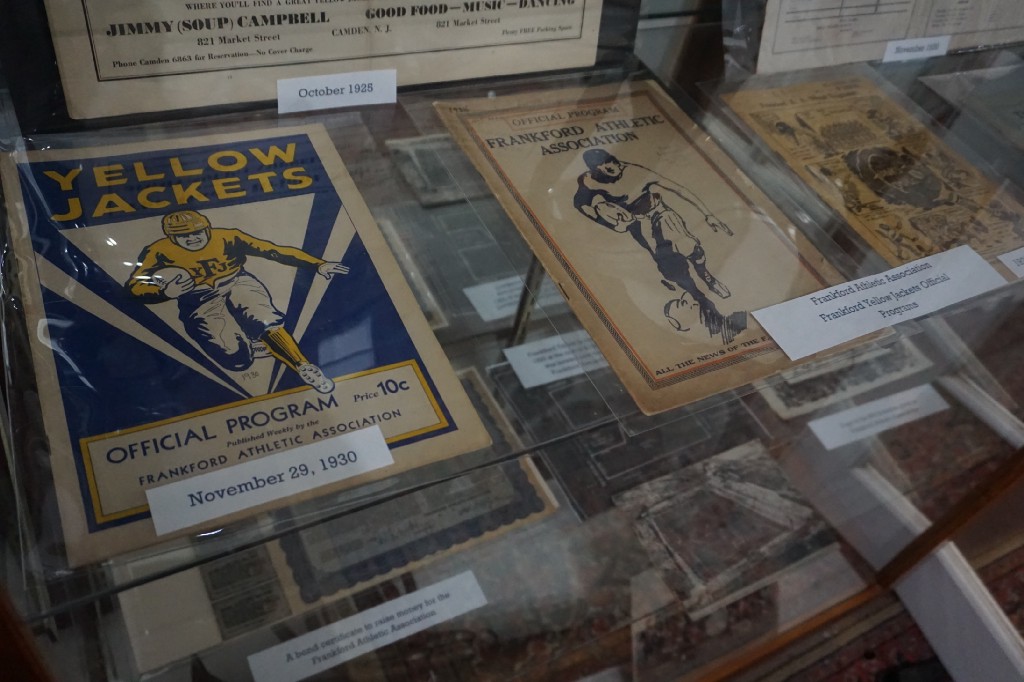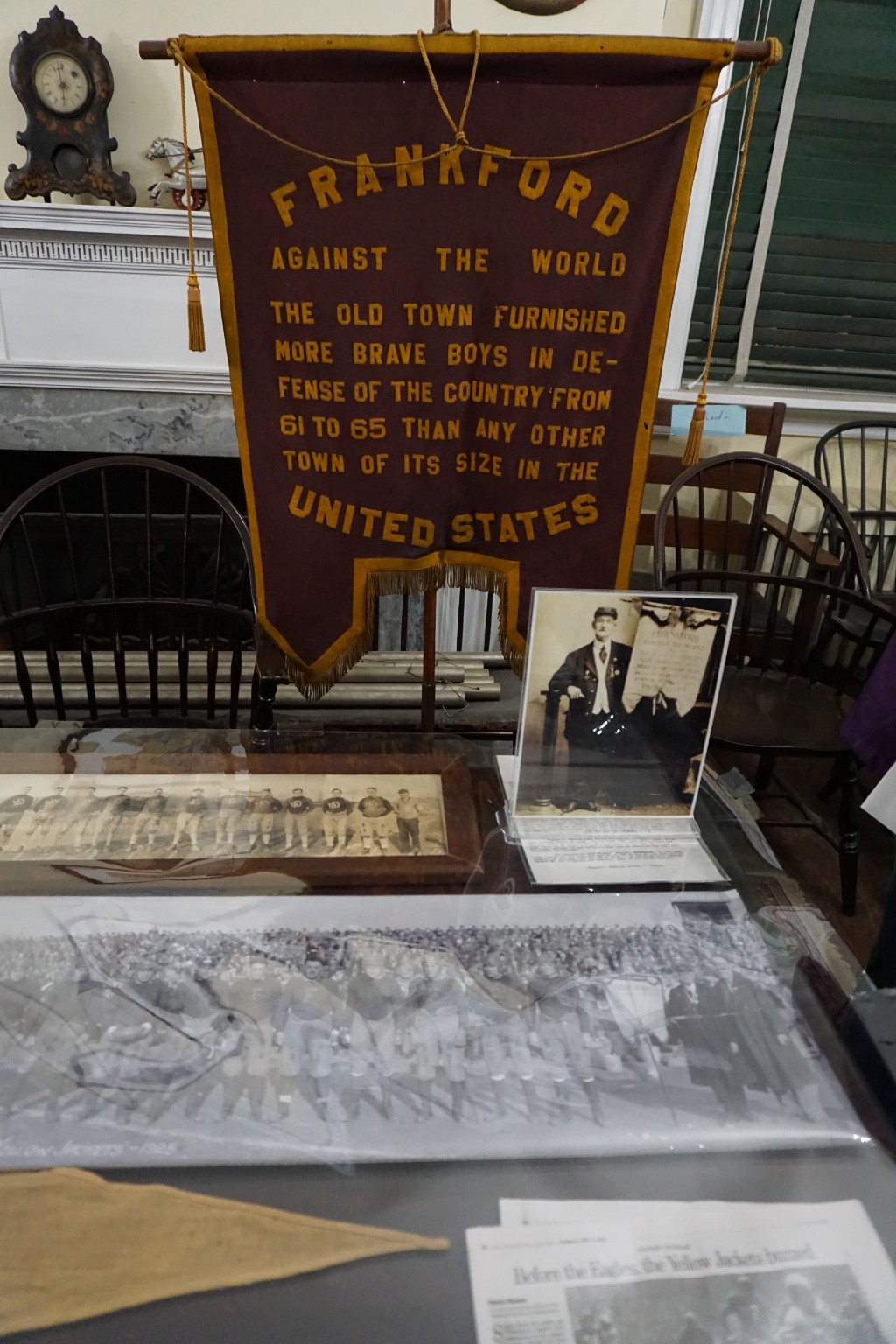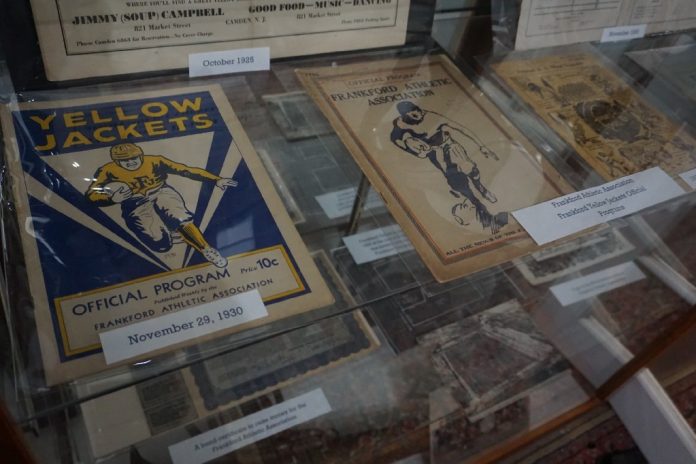Historical Society of Frankford is housing an exhibit on the Frankford Yellow Jackets, Philadelphia’s first NFL franchise prior to the Philadelphia Eagles.

By Melissa Komar
Before the Vince Lombardi trophy made its way up Broad Street, before the “Philly Special” was a twinkle in Doug Pederson’s or Nick Foles’ eye, and nearly 100 years before a $177.2 million league salary cap existed, there were the Frankford Yellow Jackets, Philadelphia’s original NFL franchise, with $5 salaries being the norm.
The Bridesburg Historical Society recently took a field trip to the Historical Society of Frankford, 1507 Orthodox St., to view artifacts from the team that paved the way for the modern-era Philadelphia Eagles.
A screen pass away from Bridesburg, Frankford shares history and many borders with the River Wards neighborhood, according to Kathleen O’Hanlon, president of the Bridesburg Historical Society.
“Our relationship is unique because our boundaries connect so much, so we wanted to share our group’s history,” she said. “The ZIP codes almost overlap. In many cases, one side of a street will be Frankford and the other will be Bridesburg.”
And, why pass up the opportunity to see where Philly pigskin began, just outside their own backyard?
Jim Young, president of the Historical Society of Frankford, gave a brief presentation, detailing the history of the team.

“The general idea is, in 1899, the Frankford Athletic Organization was formed, just a bunch of sandlot teams, basically,” Young said. “They played Holmesburg, and Jefferson Hospital had a team, and they expanded who they were playing and started going up and down the East Coast playing teams.”
When the NFL formed as the American Professional Football Association in 1920, the Frankford Yellow Jackets didn’t join at first, but played the NFL teams, including those from Chicago and New York.
And, they won, according to Young.
“They had a record of .700, playing about 25 games a year,” he said. “They played the Green Bay Packers. They played Jim Thorpe. They played against these legends. They competed against quality competition and won.”
“In 1924, they joined the league and became an NFL franchise,” Young said. “They were doing great. Won the championship in 1926. And, then, things went bad. Their stadium burned down in 1928.”
Before joining the league, the organization built Frankford Stadium on Frankford Avenue that could hold 9,000 people.
Based on maps and photographs, the end zone was located where Aramingo turns into Harbison today.
Because Pennsylvania’s Blue Laws were in place, which banned activities on Sundays due to religious reasons, the team couldn’t secure any nearby stadiums for playing time and with the Great Depression setting in, the team went broke in 1931, according to Young.
Bert Bell, who would go on to be the NFL commissioner from 1945 to 1959, and James “Lud” Wray, who was a center for the Yellow Jackets, bought the franchise, paid off its debt and in 1935, changed the name to the Philadelphia Eagles, but retained the yellow and blue colors of the yellow jackets — remember that blowout victory over the Lions in 2007 when the Eagles donned their “throwback” uniforms?
The name was changed to pay homage to President Franklin Roosevelt’s National Recovery Act, its symbol being an eagle.
In 1941, the Eagles again found themselves in financial distress, and Art Rooney, the founder of the Pittsburgh Steelers, bought 70 percent interest in the franchise, with Bell retaining the other 30 percent.
During World War II, the Steelers also ran into financial difficulty and briefly merged with the Philadelphia Eagles, becoming the Steagles for the 1943 season, until the end of the war when their players returned from the war.
Fast forward decades later with Jason Kelce’s “We Don’t Care” attitude on full, colorful display on the Art Museum of Philadelphia steps, and it’s hard to imagine anything other than a city that “bleeds green.”
But, the proof of the past remains.
After Young’s presentation, guests were able to view artifacts of the Frankford Yellow Jackets, including team photographs, a team banner, game programs complete with dates and team rosters, an authentic football and a copy of the franchise license.
“It’s unbelievable that this happened,” Young said. “It really blew my mind that this little township, this little borough, this little neighborhood of Frankford had an NFL franchise. And, they started out as a little sandlot team. ” ••
Groups interested in seeing the Frankford Yellow Jackets exhibit should call and leave a message for the Historical Society of Frankford at 215–743–6030.
Melissa Komar can be reached at [email protected]





